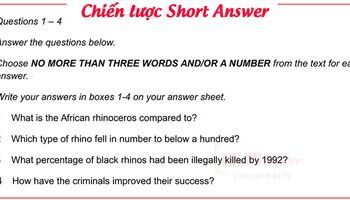Một trong các dạng câu hỏi IELTS Reading được dùng để kiểm tra kỹ năng đọc của người học chính là dạng Short Answer Question – câu hỏi ngắn.Trong dạng bài này, bạn sẽ được yêu cầu điền vào chỗ trống thông tin cần thiết đã được nhắc tới trong bài để trả lời cho câu hỏi.
Sau khi tìm hiểu về 4 dạng câu hỏi Matching, True/False/Notgiven thì hôm nay chúng ta cùng chinh chiến với dạng Short Answer nhé các bạn.
Xem video nha:
Format Short Answer question
Đây là format đề thi Reading dạng câu hỏi Short Answer:

Các bước làm bài Short Answer
Bước 1: Đọc thật kỹ yêu cầu đề bài
Bước 2: Gạch chân từ khóa trong câu hỏi và đưa ra dự đoán
Bước 3: Tìm từ khóa trong bài đọc theo thứ tự
Bước 4: Chọn đáp án đúng
Phân tích
Bước 1: Đọc thật kỹ yêu cầu đề bài
Phân tích ví dụ:
Đề bài yêu cầu “NO MORE THAN THREE WORDS AND/OR A NUMBER from the text”
1. NO MORE THAN THREE WORDS AND/OR A NUMBER nghĩa là number = one word
Khi bạn gặp dạng câu hỏi này, một số (number) được tính là một từ. Do đó, 25 October gồm một từ và số sẽ được tính là 2 từ. Một ví dụ khác là March 31 gồm một từ và một số. Ví dụ này đồng thời được chấp nhận với câu hỏi yêu cầu one word and/or a number. Hay March 31st, 1972 là 3 words and/or numbers vì “st” không tính. Nếu đề bài yêu cầu chỉ one word and/or a number đáp án sẽ là 31 March. Hay “a capital city” sẽ là 3 từ, mạo từ “a” cũng sẽ được tính như 1 từ. Và những từ có dấu gạch ngang như out-of-date (hết hạn) cũng sẽ tính là 1 từ.
2. …FROM THE TEXT
Khi bạn gặp cụm từ này thì bạn phải nhớ 2 điều: 1 là chỉ sử dụng những từ được lấy ra từ bài đọc thôi; 2 là bạn không được phép thay đổi từ vựng đó, thay đổi form, dùng paraphrase hay synonyms đều không được chấp nhận.
Còn nếu đề bài không nói cụm từ “from the text” này, bạn có thể dùng những từ đồng nghĩa hoặc cụm từ tương đương khác miễn sao nghĩa vẫn đúng, lưu ý chỉ trong giới hạn số từ được dùng.
Bước 2: Gạch chân từ khóa trong câu hỏi và đưa ra dự đoán
Keywords (Từ khóa) sẽ có 2 dạng từ khóa: Changeable keywords và Unchangeable Keywords.
- Changeable keywords là những từ khóa có thể biến đổi được trong bài. Là những Từ có khả năng bị paraphrase hoặc (Cụm) Danh từ, động từ, tính từ…
- Unchangeable keywords là những từ khóa không bị biến đổi, ví dụ như: tên riêng, tên khoa học, con số, dữ liệu, ngày tháng…
Phân tích ví dụ sau:
Question 1. What has been found in some Fancy Foods products?
Question 2. Where can you find the batch number on the jars?
Câu 1: từ khóa là found, Fancy Foods, products.
Dự đoán: Câu này từ để hỏi là what (cái gì) à Cái gì được tìm thấy trong sản phẩm của Fancy Foods? à Câu trả lời là 1 danh từ (noun), 1 thứ gì đó (something)
Câu 2: từ khóa là batch number, jars
Dự đoán: Câu này là từ để hỏi là where (ở đâu) à Bạn có thể tìm thấy số hiệu lô hàng ở đâu trên lọ? Vậy câu trả lời là 1 danh từ chỉ vị trí (position)
Bước 3: Tìm từ khóa trong bài đọc theo thứ tự
Từ khóa chúng ta có thể thấy trong bài đọc nằm ở đoạn:
Fancy Foods wishes to inform the public that pieces of metal have been found in some jars of Fancy Foods Chicken Curry (Spicy). The batches of the Jars involved have numbers from J6617 to J6624. The batch number is printed on the bottom of each jar.
Từ khóa: Fancy Foods, have been found, jars of Fancy Foods Chicken Curry, batch number, jars.
Bước 4: Chọn đáp án đúng
Question 1. What has been found in some Fancy Foods products?
Cái gì được tìm thấy trong sản phẩm của Fancy Foods?
Đoạn: Fancy Foods wishes to inform the public that pieces of metal have been found in some jars of Fancy Foods Chicken Curry (Spicy). – Hãng Fancy Foods muốn thông báo đến cộng đồng là có một mảnh kim loại đã được tìm thấy trong 1 số lọ cà ri gà (cay) của Fancy Foods.
Ta có Fancy Foods Chicken Curry (Spicy) = Fancy Foods products
Đáp án cần tìm là “something” à Đáp án là “pieces of metal” – mảnh kim loại
Question 2. Where can you find the batch number on the jars?
Bạn có thể tìm thấy số hiệu lô hàng ở đâu trên lọ?
Đoạn: The batches of the Jars involved have numbers from J6617 to J6624. The batch number is printed on the bottom of each jar. – Các lô hàng liên quan được đánh số từ J6617 đến J6624. Số hiệu lô hàng được in trên đáy của mỗi lọ.
Đáp án cần tìm là “position”à Đáp án là “on the bottom” – dưới đáy
Chốt đáp án:
Question 1. pieces of metal
Question 2. on the bottom
Check- up 1
History of telegraph in communication
Jean-Antoine Nollet was a French clergyman and physicist. In 1746 he gathered about two hundred monks into a circle about a mile (1.6 km) in circumference, with pieces iron wire connecting them. He then discharged a battery of Leyden jars through the human chain and observed that each man reacted at substantially the same time to the electric shock, showing that the speed of electricity's propagation was very high. Given a more humane detection system, this could be a way of signaling over long distances. In 1 748, Nollet invented one of the first electrometers, the electroscope, which detected the presence of an electric charge by using electrostatic attraction and repulsion.
After the introduction of the European semaphore lines in 1792, the world's desire to further its ability to communicate from a distance only grew. People wanted a way to send and receive news from remote locations so that they could better understand what was happening in the world around them—not just what was going on in their immediate town or city. This type of communication not only appealed to the media industry, but also to private individuals and companies who wished to stay in touch with contacts. In 1840 Charles Wheatstone from Britain, with William Cooke, obtained a new patent for a telegraphic arrangement. The new apparatus required only a single pair of wires, but the telegraph was still too costly for general purposes. In 1 845, however, Cooke and Wheatstone succeeded in producing the single needle apparatus, which they patented,and from that time the electric telegraph became a practical instrument, soon adopted on all the railway lines of the country.
It was the European optical telegraph, or semaphore, that was the predecessor of the electrical recording telegraph that changed the history of communication forever. Building on the success of the optical telegraph, Samuel F. B. Morse completed a working version of the electrical recording telegraph, which only required a single wire to send code of dots and dashes. At first, it was imagined that only a few highly skilled encoders would be able to use it but it soon became clear that many people could become proficient in Morse code. A system of lines strung on telegraph poles began to spread in Europe and America.
In the 1840s and 1850s several individuals proposed or advocated construction of a telegraph cable across the Atlantic Ocean, including Edward Thornton and Alonzo Jackman. At that time there was no material available for cable insulation and the first breakthrough came with the discovery of a rubber-like latex called gutta percha. Introduced to Britain in 1843, gutta percha is the gum of a tree native to the Malay Peninsula and Malaysia. After the failure of their first cable in 1850, the British brothers John and Jacob Brett laid a successful submarine cable from Dover to Calais in 1851. This used two layers of gutta percha insulation and an armoured outer layer. With thin wire and thick insulation, it floated and had to be weighed down with lead pipe.
In the case of first submarine-cable telegraphy, there was the limitation of knowledge of how its electrical properties were affected by water. The voltage which may be impressed on the cable was limited to a definite value. Moreover, for certain reasons, the cable had an impedance associated with it at the sending end which could make the voltage on the cable differ from the voltage applied to the sending-end apparatus. In fact, the cable was too big for a single boat, so two had to start in the middle of the Atlantic, join their cables and sail in opposite directions. Amazingly, the first official telegram to pass between two continents was a letter of congratulation from Queen Victoria of the United Kingdom to the President of the United States, James Buchanan, on August 16, 1 858. However, signal quality declined rapidly, slowing transmission to an almost unusable speed and the cable was destroyed the following month.
To complete the link between England and Australia, John Pender formed the British- Australian Telegraph Company. The first stage was to lay a 557nm cable from Singapore to Batavia on the island of Java in 1870. It seemed likely that it would come ashore qt the northern port of Darwin from where it might connect around the coast to Queensland and New South Wales. It was an undertaking more ambitious than spanning ocean. Flocks of sheep had to be driven with the 400 workers to provide food. They needed horses and bullock carts and, for the parched interior, camels. In the north, tropical rains left the teams flooded. In the centre, it seemed that they would die of thirst. One critical section in the red heart of Australia involved finding a route through the McDonnell mountain range and then finding water on the other side. The water was not only essential for the construction teams. There had to be telegraph repeater stations every few hundred miles to boost the signal and the staff obviously had to have a supply of water.
On August 22, 1872, the Northern and Southern sections of the Overland Telegraph Line were connected, uniting the Australian continent and within a few months, Australia was at last in direct contact with England via the submarine cable, too. This allowed the Australian Government to receive news from around the world almost instantaneously for the first time. It could cost several pounds to send a message and it might take several hours for it to reach its destination on the other side of the globe, but the world would never be the same again. The telegraph was the first form of communication over a great distance and was a landmark in human history.
Questions 33 - 40
Answer the questions below. Choose NO MORE THAN TWO WORDS from the passage for each answer. Write your answers in boxes 33-40 on your answer sheet.
33. Why did Charles Wheatstone’s telegraph system fail to come into common use in the beginning?
-> ......
34. What material was used for insulating cable across the sea?
-> ......
35. What was used by British pioneers to increase the weight of the cable in the sea?
-> ......
36. What would occur in the submarine cable when the voltage was applied?
-> ......
37. Who was a message first sent to across the Atlantic by the Queen?
-> ......
38. What animals were used to carry the cable through desert?
-> ......
39. What weather condition delayed construction in north Australia?
-> ......
40. How long did it take to send a telegraph message from Australia to England in 1872?
-> ......
Các mẹo làm bài
Mẹo 1: Câu hỏi được thực hiện theo trật tự của bài đọc
Phân tích ví dụ sau:
Đoạn 5: Bovids are the largest of 10 extant families within Artiodactyla, consisting of more than 140 extant and 300 extinct species. Fossil evidence suggests five distinct subfamilies: Bovinae (bison, buffalos, cattle, and relatives). Antelope (addax, oryxes, roan antelopes and relatives), Caprinae (chamois, goats, sheep, and relatives), Cephalophinae (duikers), and Antilocapridae (pronghorn). Unlike most other bovids, Bovinae species are ail non-territorial. As the ancestors of the various species of domestic cattle, banteng, gaur, yak and water buffalo are generally rare and endangered in the wild, while another ancestor, auroch, has been extinct in the wild for nearly 300 years.
Đoạn 6: Antelope is not a cladistic or taxonomically defined group. The term is used to describe all members of the family Bovidae that do not fall under the category of , cattle, or goats. Not surprisingly for animals with long, slender yet powerful legs, many antelopes have long strides and can run fast. There are two main sub-groups of antelope: Hippotraginae, which includes the oryx and the addax, and Antilopinae, which generally contains slighter and more graceful animals such as gazelle and the springbok. The antelope is found in a wide range of habitats, typically woodland, forest, savannah, grassland plains, and marshes. Several species of antelope have adapted to living in the mountains and rocky outcrops and a couple of species of antelope are even semi-aquatic and these antelope live in swamps, for instance, the sitatunga has long, splayed hooves that enable it to walk freely and rapidly on swampy ground.
Question 10: Which member of Bovinae has died out?
Question 11: What helps sitatunga move quickly on swampy lands?
Ta có thể tìm thấy đáp án cho câu 10 ở đoạn 5, theo trật tự thì đáp án cho câu 11 sẽ được tìm thấy ở đoạn văn tiếp theo là đoạn văn thứ 6.
Mẹo 2: Đọc câu hỏi rồi mới đọc đoạn văn, hiểu rõ ý của câu hỏi rồi mới tìm câu trả lời
Nhiều bạn chọn cách đọc đoạn văn trước khi đọc câu hỏi là rất sai lầm, vì thông tin trong bài đọc rất nhiều, đọc bài đọc trước sẽ tốn nhiều thời gian và không biết thông tin nào là thông tin mình cần nhớ và khi quay lại đọc câu hỏi các bạn sẽ rất dễ quên các thông tin mà mình vừa đọc, dẫn đến việc đọc đoạn văn lần thứ 2. Chính vì vậy, đọc hỏi và các đáp án lựa chọn trước sẽ giúp bạn tiết kiệm thời gian đọc, vì lúc đó bạn đã biết thông tin mình cần đọc và ghi nhớ là gì và chỉ cần phải đọc đoạn văn 1 lần.
Mẹo 3: Câu trả lời không nhất thiết phải đúng ngữ pháp, chỉ cần đúng ý câu hỏi là được.
Vì số lượng từ giới hạn, nên các đáp án thường thì chỉ có thể là một từ hoặc một cụm từ, rất ít khi là một câu hoàn chỉnh ngữ pháp có chủ vị
Ví dụ:
Question 10: Which member of Bovinae has died out?
Đáp án: auroch
Thông tin: As the ancestors of the various species of domestic cattle, banteng, gaur, yak and water buffalo are generally rare and endangered in the wild, while another ancestor, auroch, has been extinct in the wild for nearly 300 years.
Mẹo 4: Khi có keywords, luôn nhớ sang từ đồng nghĩa - synonyms và paraphrases để tìm thông tin.
Tiếp tục phân tích ví dụ trên:
Thông tin: As the ancestors of the various species of domestic cattle, banteng, gaur, yak and water buffalo are generally rare and endangered in the wild, while another ancestor, auroch, has been extinct in the wild for nearly 300 years.
Question 10: Which member of Bovinae has died out?
Keyword trong câu hỏi là từ “died out” (tuyệt chủng) tuy nhiên trong bài lại không xuất hiện từ “died out”, thay vào đó là từ đồng nghĩa “extinct”.
Thông tin: Several species of antelope have adapted to living in the mountains and rocky outcrops and a couple of species of antelope are even semi-aquatic and these antelope live in swamps, for instance, the sitatunga has long, splayed hooves that enable it to walk freely and rapidly on swampy ground.
Question 11: What helps sitatunga move quickly on swampy lands?
Trong câu hỏi keyword cần lưu ý là “helps/ move quickly” nhưng ta không thể tìm thấy keywords đó trong thông tin bài đọc, thay vào đó là cụm paraphrase “enable it to walk freely and rapidly”
Mẹo 5: Lấy thông tin từ bài đọc, không trả lời bằng ý kiến cá nhân
Không suy đoán câu trả lời từ sự hiểu biết, suy đoán hoặc ý kiến cá nhân vì rất có thể đó không phải là câu trả lời đúng. Lưu ý quan trọng là đáp án phải là những từ lấy từ bài đọc, nên bắt buộc không được tự ý viết bằng ngôn ngữ, từ của mình.
Luyện tập có đáp án
PASSAGE 1
The culture of Chimpanzees
Humankind's nearest relative is even doser than we thought: chimpanzees display remarkable behaviours that can only be described as social customs passed on from generation to generation.
A. Researchers have studied the similarities between chimpanzees and humans for years, but in the past decade they have determined that these resemblances run much deeper than anyone first thought. For instance, the nut cracking observed in the Tai Forest is far from a simple chimpanzee behaviour; rather it is a singular adaptation found only in that particular part of Africa and a trait that biologists consider to be an expression of chimpanzee culture. Scientists frequently use the term “culture” to describe elementary animal behaviours, but as it turns out, the rich and varied cultural traditions found among chimpanzees are second in complexity only to human traditions.
B. During the past two years, an unprecedented scientific collaboration, involving every major research group studying chimpanzees, has documented a multitude of distinct cultural patterns extending across Africa, in actions ranging from the animals’ use of tools to their forms of communications and social customs. This emerging picture of chimpanzees not only affects how we think of these amazing creatures but also alters human beings’ conception of our own uniqueness and hints at ancient foundations for extraordinary capacity for culture.
C. Homo sapiens and Pan troglodytes have coexisted for hundreds of millennia and share more than 98 percent of their genetic material, yet only 40 years ago we still knew next to nothing about chimpanzee behaviour in the wild. That began to change in the 1960s, when Toshisada Nishida of Kyoto University in Japan and Jane Goodall began their studies of wild chimpanzees at two field sites in Tanzania. Goodall’s research station at Gombe—the first of its kind—is more famous.
D. In these initial studies, as the chimpanzees became accustomed to close observation, the remarkable discoveries began. Researchers witnessed a range of unexpected behaviours, including fashioning and using tools, hunting, meat eating, food sharing and lethal fights between members of neighbouring communities. In the years that followed, other primatologists set up camp elsewhere, and, despite all the financial, political and logistical problems that can beset African fieldwork, several of these out-posts became truly long-term projects. As a result, we live in an unprecedented time, when an intimate and comprehensive scientific record of chimpanzees’ lives at last exists not just for one but for several communities spread across Africa.
E. As early as 1973, Goodall recorded 13 forms of tool use as well as eight social activities that appeared to differ between the Gombe chimpanzees and chimpanzee populations elsewhere. She ventured that some variations had what she termed a cultural origin. But what exactly did Goodall mean by “culture”? The diversity of human cultures extends from technological variations to marriage rituals, from culinary habits to myths and legends. Animals do not have myths and legends, of course. But they do have the capacity to pass on behavioural traits from generation to generation, not through their genes but by learning. For biologists, this is the fundamental criterion for a cultural trait: it must be something that can be learned by observing the established skills of others and thus passed on to future generations.
F. What of the implications for chimpanzees themselves? We must highlight the tragic loss of chimpanzees, whose populations are being decimated just when we are at last coming to appreciate these astonishing animals more completely. The bushmeat trade is particularly alarming: logging has driven roadways into the forests that are now used to ship wild-animal meat— including chimpanzee meat—to consumers as far afield as Europe. Such destruction threatens not only the animals themselves but also a host of fascinatingly different ape cultures.
G. Perhaps the cultural richness of the ape may yet help in its salvation, however. Some conservation efforts have already altered the attitudes of some local people. A few organizations have begun to show videotapes illustrating the cognitive prowess of chimpanzees. One Zairian viewer was heard to exclaim, “Ah, this ape is so like me, I can no longer eat him.”
H. How an international team of chimpanzee experts conduct the most comprehensive survey of the animals ever attempted? Scientists have been investigating chimpanzee culture for several decades, but too often their studies have contained a crucial flaw. Most attempts to document cultural diversity among chimpanzees have relied solely on officially published accounts of the behaviours recorded at each research site. But this approach probably overlooks a good deal of cultural variation for three reasons.
I. Firstly, scientists typically don’t publish an extensive list of all the activities they do not see at a particular location. Yet this is exactly what we need to know—which behaviours were and were not observed at each site. Second, many reports describe chimpanzee behaviours without saying how common they are; without this information, we can’t determine whether a particular action was a once-in-a-lifetime aberration or a routine event that should be considered part of the animals’ culture. Finally, researchers’ descriptions of potentially significant chimpanzee behaviour frequently lack sufficient detail, making it difficult for scientists working at other spots to record the presence or absence of the activities.
J. To remedy these problems, the two of us decided to take a new approach. We asked field researchers at each site for a list of all the behaviours they suspected were local traditions. With this information in hand, we pulled together a comprehensive list of 65 candidates for cultural behaviours.
K. Then we distributed our list to the team leaders at each site. In consultation with their colleagues, they classified each behaviour in terms of its occurrence or absence in the chimpanzee community studied. The key categories were customary behaviour, habitual, present, absent, and unknown. We should note, however, that certain cultural traits are no doubt passed on by a combination of imitation and simpler kinds of social learning. Either way, learning from elders is crucial to growing up as a competent wild chimpanzee.
Questions 23 - 26
Answer the questions below.
Choose NO MORE THAN THREE WORDS AND / OR A NUMBER from passage for each answer.
Write your answers in boxes 23-26 on your answer sheet.
23. When did the unexpected discoveries of chimpanzee behaviour start?
-> ....
24. Which country is the research site of Toshisada Nishida and Jane Goodall?
-> ....
25. What did the chimpanzees have to get used to in the initial study?
-> ....
26. What term did Jane Goodall use in 1973 to explain groups of chimpanzees using tools differently?
-> ....
Đáp án:
Check-up 1
- Đáp án: (Too) costly
Thông tin cho câu hỏi này nằm ở phần chót cuối của đoạn văn thứ hai “The new apparatus required only a single pair of wires, but the telegraph was still too costly for general purposes”.
- Đáp án: Gutta percha
Thông tin cho câu hỏi này nằm ở phần giữa của đoạn văn thứ 4 “At that time there was no material available for cable insulation and the first breakthrough came with the discovery of a rubber-like latex called gutta percha”.
- Đáp án: Lead pipe
Thông tin cho câu hỏi này nằm ở câu cuối đoạn văn thứ 4 “With thin wire and thick insulation, it floated and had to be weighed down with lead pipe”
- Đáp án: Impedance
Thông tin cho câu hỏi này nằm ở câu văn thứ ba đoạn thứ năm “Moreover, for certain reasons, the cable had an impedance associated with it at the sending end which could make the voltage on the cable differ from the voltage applied to the sending-end apparatus”.
- Đáp án: James Buchanan
Thông tin cho câu hỏi này nằm ở câu chót cuối đoạn văn thứ 5 “Amazingly, the first official telegram to pass between two continents was a letter of congratulation from Queen Victoria of the United Kingdom to the President of the United States, James Buchanan, on August 16, 1858”
- Đáp án: camels
Thông tin cho câu hỏi này nằm ở câu giữa đoạn văn thứ 6 “They needed horses and bullock carts and, for the parched interior, camels”.
- Đáp án: Tropical rains
Thông tin cho câu hỏi này nằm ở câu tiếp theo của câu văn ở câu 38 “In the north, tropical rains left the teams flooded”.
- Đáp án: several hours
Thông tin cho câu hỏi này nằm ở đoạn cuối bài đọc “It could cost several pounds to send a message and it might take several hours for it to reach its destination on the other side of the globe, but the world would never be the same again”
Check-up 2
12. Đáp án: arid deserts
Thông tin cho câu hỏi nằm ở câu cuối đoạn văn thứ 7 “Barbary and bighorn sheep have been found in arid deserts, while Rocky Mountain sheep survive high up in mountains and musk oxen in arctic tundra”.
13. Đáp án: Pronghorn
Thông tin cho câu hỏi nằm ở câu đầu tiên trong đoạn văn cuối cùng “The pronghorn is the only living member of the sub-family Antilocapridae in North America”.
PASSAGE 1
23. Đáp án: in 1960s
24. Đáp án: Tanzania
Đáp án cho câu hỏi nằm ở đầu đoạn văn D “In these initial studies, as the chimpanzees became accustomed to close observation, the remarkable discoveries began”.
25. Đáp án: close observation
Đáp án cho câu hỏi ở đoạn văn D “In these initial studies, as the chimpanzees became accustomed to close observation, the remarkable discoveries began”.
26. Đáp án: cultural origin
Đáp án cho câu hỏi ở đoạn văn E “She ventured that some variations had what she termed a cultural origin”.
Thế là chúng ta đã tìm hiểu xong dạng bài Short Answer rồi, các bạn luyện tập tốt nhé.
Bài viết phân tích dựa theo các đề thật được ra trong năm, được thực hiện bởi IELTS Fighter, vui lòng ghi nguồn nếu sử dụng chia sẻ. Xin cảm ơn.
Xem thêm dạng bài khác:
Chiến thuật làm bài MATCHING HEADINGS
IELTS Reading: Chiến lược làm bài MULTIPLE CHOICE





